Trackside Signs
A number of special-purpose signs are located along the railway to provide instructions and reminders to railway personnel.
There are some additional examples of trackside signs on the Trackside Detail reference images page.
Speed Limits
There are a number of different signs relating to speed limits. The basic speed limit sign sets the maximum allowed speed over a section of track beyond the sign. Note that this maximum is not allowed in all cases: signals modify maximum speed limits, and other restrictions can apply. A signal can only reduce the speed allowed (i.e., if the speed limit is 75 kph, a signal may restrict a train to a lower speed but may not authorize a higher one). A “clear” (green) signal means to operate at the highest speed allowed for the train, which may be less than the speed limit set by the sign, depending on the type of trains (e.g., freight versus passenger) or be restricted for a given train due to the cars in it (some freight cars have maximum allowed speeds, for example).
Speed Limit
A speed limit sign is typically a low white sign, either square or circular, containing a black number representing the speed limit in kilometers per hour. However, there are related signs, as well as variations on this. Additionally, circular signs with numbers may be used for other purposes, such as ATC block numbers (those are typically white numbers on a black sign).
A speed limit sign indicates the point at which a speed limit becomes in effect. If this is a limited-distance restriction, a second number may be provided below a dividing line that indicates the distance for which the limitation is in effect [source?].
Use of an arrow - When a speed limit applies to a diverging route, an arrow pointing in the direction of the divergence is placed under the sign (the example I’ve seen shows a separate rectangular white signboard with a black arrow).
Red border - A speed limit sign with a red border is a particular type of limit, called a “速度照査用” (“Verification For Speed”), but I’m not sure what it means. It appears to be a type of speed limit associated with ATS (automatic train signaling) providing a safety limit (e.g., through a curve or near construction work) that is enforced by the ATS system, but how that differs from a normal speed limit (which should also be enforced) isn’t really clear to me.
If a speed limit applies only to the branching route of a turnout, the corners pointing in that direction will be colored black.



Speed Limit signs (click on image for link to original for credits, if no link original was removed from web after acquisition and photographer unknown)
End Speed Limit
A square with white (pointing horizontally) and black (pointing vertically) triangles forming a cross marks the end of a speed restriction. This is called a (“Speed Limit Signs Removed”) or “速度制限解除標識” (“end speed limit sign”).

End Speed Limit Sign
Artist: Hakatanoshio117117
Stop Signs
Unlike for automobiles, the railway stop sign isn’t a command to stop, but a marker of the point at which a train must stop if something else requires it to do so. This is similar to the white line painted on a roadway adjacent to a stop sign. This usually designates a point where proceeding further would interfere with other trains in some manner, either by activating a track detection circuit, or by preventing a train on an adjacent track from having adequate clearance to proceed (e.g., at a switch where a train ahead can divert to or enter from a line parallel to the stopped train).


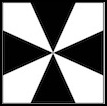
Train, Vehicle and Car Stop Signs/Markers
Artist: Hakatanoshio117117
“Train Stop Sign” (or “標識 列車停止”, the “列車” part, “ressha”, means train) - A white square, with a vertical/horizontal black cross - when a signal cannot be placed where the train is to stop (due to construction or other causes), this sign marks the place where the train must stop when the signal displays the “Stop” aspect.
“Vehicle Stop Sign” (or 車両停止標識, the “車両” part, “Sharyō”, means vehicle) - A black square, with a vertical/horizontal white cross - It’s unclear to me exactly how this differs from the “Train Stop Sign”, except that the description does not mention temporary conditions such as construction. I have seen it placed at the end of a platform, likely marking the stopping position before the train would trigger a track circuit on the departure track.
Car Stop Marker
The Car Stop Marker (aka “Bollard Sign” or 車止標識, the “車” part, “kuruma”, means car) is a black square with a white diagonal cross - an optional marker placed on a barrier at the end of track, to warn cars to stop (Kato supplies models of these with their “bumper” tracks).
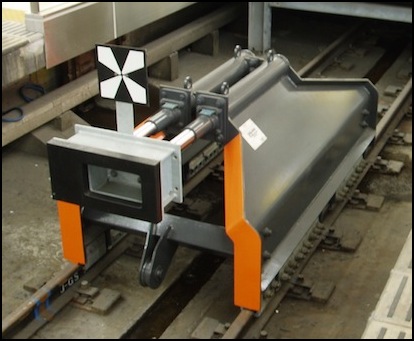
End of Track bumper with sign, Odakyu Railway, Shinjuku Station (Tōkyō, 2006)
Photographer: Cassiopeia_sweet
Target Stop Position
The Target Stop Position indicator is a red and/or yellow marker (or markers) attached to the ties between the rails indicate where a train must stop (red). A yellow version with a number can indicate a different stopping point for trains with a specific (or longer?) number of cars. These appear to be used both at switches to indicate clearance/track sensor boundaries, and in stations to mark stopping positions for placing doors in the correct place on the platform.
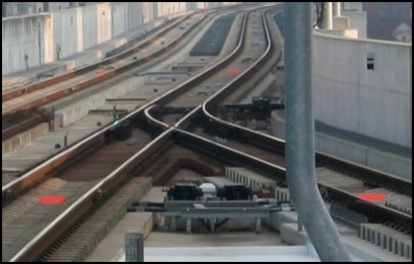
Target Stop Position Markers between rails (Osaka, 2006)
Railway: unidentified JR line
Photographer: zeraien
Clearance Point Sign
The Vehicle Contact Limit Sign (literally “Limit Signs Vehicle Contact” or 車両接触限界標識) is a small triangular marker attached to a tie outside the track, presenting a white face to an oncoming train, is used to mark the clearance point at a switch or similar location. This is the point by which a train must stop in order to prevent it from interfering with a train on an adjacent track (e.g., at a switch where a train ahead can divert to or enter from a line parallel to the stopped train). Some of these have numerals on the sign, although it’s unclear to me what these indicate. As seen in the Target Stop Position example, there can be other ways to indicate the required stopping point.
Block and Train Control Signs
Several signs are used, either trackside or on a signal pole, to indicate the boundaries between train control blocks. On lines without external signals, such as Shinkansen lines, these will be placed on short poles adjacent to the track, otherwise they are typically attached to the signal mast below the signal heads.
Block Identifiers - This are often orange triangles pointing upward, containing either the number of the track block, or the kanji “出” (“out”) to indicate the starting block. The black one below is on a Shinkansen line. The yellow triangle version is apparently called a “Mark Position Signal” sign (which may mean “block signal marker”).
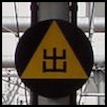
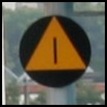
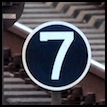
Starting and Block Signal Signs
Photographer: click on image for link to original for credit
A variant of this puts a number above the “out” kanji. This appears to be used where the assignment of a signal to the rail line is ambiguous, to clarify which signal is associated with which line. In the photo below, the two signals are between the tracks at a station exit, and thus the left one is on the “wrong’ side of the tracks, and could be misread as applying to the right line. I presume the numbers here are track numbers rather than block numbers.
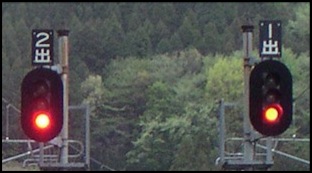
Starting signals (2006)
Railway: Itsukaichi Line at Musashi-Itsukaichi Station
Photographer: っ (Tsu)
The “Home” signal at a station is a special signal. A Home signal will normally be marked with a block sign (orange triangle) bearing the kanji “場” (“place”).
ATC “End of Track Circuit” sign - Orange sign with a vertical/horizontal black cross - this marks the end of a track circuit for ATC. These are places at the end of platforms in a station (separating the station from the first block, I believe) and at the end of the track. This may only be used with Shinkansen (so far those are the only examples I’ve found). I’ve also seen this called a “Limit Stop Sign” (“停止限界標識”).
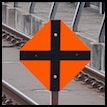
End of Track Circuit Sign (2010)
Railway: Tōhoku Shinkansen, Ōmiya Station
Photographer: toshinori baba
Other Signs
Mark approaching depot - yellow square with a diagonal black slash (top right to lower left) - indication that there is a depot ahead (apparently used where the depot would not be visible to an approaching train).
Check Mark Copy Stop - square divided into red (lower left) and green (upper right) triangles - Notice to the train driver to stop to check in (I think, but I may be misreading it).
One Man Sign
This is an interesting sign. The katakana (“ワンマン”) reads “wanman”, as close as katakana gets to “one man” (it’s a common phrase, also used on busses by report to mean driver-only operation without a conductor). The kanji appears to be “気” (meaning “air”, “mood”, “essence” or “intention”; it’s meaning here is unclear). It’s probably designating a special stopping point for driver-only trains. From the placement, I think it applies to trains on the Hachikō Line (although that isn’t certain). These would be short (3-4 car) EMU or DMU trains, so one-person operation is reasonable. The meaning of the “8” likewise isn’t clear, but it’s probably a block number (there aren’t eight tracks at the station, and there aren’t any eight-car trains operating on the line that far out, as far as I can tell).
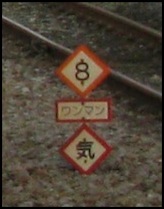
Sign at Takasaki Line Kuragano station (2010)
Photographer: LERK
References
The tenkyoku.com website contains a summary (in Japanese) of some of the Japanese railway rules on signage, among other things.
Japanese Wikipedia Automatic Train Stop System page (Japanese).
Japanese Wikipedia Railway Sign page (Japanese).
Japanese Wikipedia Speed Verification page (Japanese).
Wikipedia Japanese Railway Signals page (also Japanese version, but at present they’re much the same).




